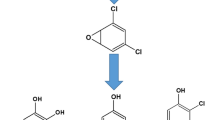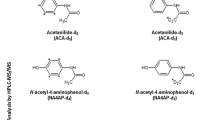Summary
Dimethylethylamine (DMEA) is an aliphatic tertiary amine, which is used is a catalyst in the mould core manufacturing. During 8 h, four healthy volunteers were exposed to four different DMEA air concentrations (10, 20, 40 and 50 mg/m3; 20 mg/m3, two subjects only). DMEA was biotransformed into dimethylethyl-amine N-oxide (DMEAO). On average, DMEAO, accounted for 90% of the combined amount of DMEA and DMEAO excreted into the urine. The half-lives of DMEA and DMEAO in plasma were 1.3 and 3.0h, respectively. The urinary excretion of DMEA and DMEAO followed a two-phase pattern. The half-lives in the first phase were 1.5 h for DMEA and 2.5 h for DMEAO. In the second phase, which started about 9 h after the end of exposure, half-lives of 7 h for DMEA and 8 h for DMEAO were recorded. The combined concentration of DMEA and DMEAO, in both plasma and urine, showed an excellent correlation with the air concentration of DMEA. Thus, both urinary excretion and plasma concentration can be used for biological monitoring of exposure to DMEA. An 8-h exposure to 10 mg DMEA/m3 corresponds to a postexposure plasma concentration and 2-h postexposure urinary excretion of 4.9 μmol/1 and 75 mmol/mol creatinine, respectively.
Similar content being viewed by others
References
Åkesson B, Skerfving S (1990) Effects of ethanol ingestion and urinary acidity of the metabolism of triethylamine in man. Int Arch Occup Environ Health 62:89–93
Åkesson B, Florén I, Skerfving S (1985) Visual disturbances after experimental human exposure to triethylamine. Br J Ind Med 42:848–850
Åkesson B, Bengtsson M, Florén I (1986) Visual disturbances by industrial triethylamine exposure. Int Arch Occup Environ Health 57:297–302
Åkesson B, Skerfving S, Mathiasson L (1988) Experimental study on the metabolism of triethylamine in man. Br J Ind Med 45:262–268
Åkesson B, Skerfving S, Ståhlbom B, Lundh T (1989a) Metabolism of triethylamine in polyurethane foam manufacturing workers. Am J Ind Med 16:255–265
Åkesson B, Vinge E, Skerfving S (1989b) Pharmacokinetics of triethylamine and triethylamine-N-oxide in man. Toxicol Appl Pharmacol 100:529–538
Albrecht WN, Stephenson RL (1988) Health hazards of tertiary amine catalysts. Scand J Work Environ Health 14:209–219
Al-Waiz M, Mitchell SC, Idle JR, Smith RL (1987a) The relative importance of N-oxidation and N-methylation in the metabolism of trimethylamine in man. Toxocology 43:117–121
Al-Waiz M, Ayesh R, Mitchell SC, Idle JR, Smith RL (1987b) Trimethylaminuria (fish-odour syndrome): an inborn error of oxidative metabolism. Lancet 1:634–635
Al-Waiz M, Mitchell SC, Idle JR, Smith RL (1987c) The metabolism of 14C-labelled trimethylamine and its N-oxide in man. Xenobiotica 17:551–558
Aronson JK, Dengler HJ, Dettli L, Folath F (1988) Standardization of symbols in clinical pharmacology. Eur J Clin Pharmacol 35:1–7
Ayesh R, Smith RL (1990) Genetic polymorphism of trimethylamine N-oxidation. Pharmacol Ther 45:387–401
Bickel HM (1971) N-Oxide formation and related reactions in drug metabolism. Xenobiotica 1:131–319
Calvert GD (1973) Trimethylaminuria and inherited Noonan's syndrome. Lancet 1:320
Clayton GD, Clayton FE (1982) Toxicology of aliphatic and alicyclic amines. In: Patty's industrial hygiene and toxicology, 3rd edn, vol IIb. Wiley Interscience, New York, pp 3135–3173
Ganong WF (1979) Glomerular filtration. In: Review of medical physiology, 9th ed. Lange Medical Publications, Los Altos, California, pp 542–544
Hansén MK, Larsen M, Cohr K-H (1987) Waterborne paints. A review of their chemistry and toxicology and the results of determinations made during their use. Scand J Environ Health 13:473–485
Lundh T, Åkesson B, Ståhlbom B (1991a) Methods for determination of dimethylethylamine and dimethylethylamine-N-oxide in air, plasma and urine samples. Int J Environ Anal Chem 44:81–86
Lundh T, Ståhlbom B, Åkesson B (1991b) Dimethylethylamine in mould core manufacturing — exposure, metabolism and biological monitoring. Br J Ind Med 48:203–207
Lustgarten JA, Wenk RE (1972) Simple, rapid kinetic method for serum creatinine measurement. Clin Chem 18:1419–1422
Ståhlbom B, Lundh T, Florén I, Åkesson B (1991) Visual disturbances in man as a result of experimental and occupational exposure to dimethylethylamine. Br J Ind Med 48:26–29
Taft RW, Abraham MH, Famini GR, Doherty RM, Abboud JLM, Kamlet MJ (1985) Solubility properties in polymers and biological media: 2. An analysis of the physico-chemical properties which influence octanol-water partition coefficients aliphatic and aromatic solutes. J Pharm Sci 74:807–814
Author information
Authors and Affiliations
Rights and permissions
About this article
Cite this article
Ståhlbom, B., Lundh, T. & Åkesson, B. Experimental study on the metabolism of dimethylethylamine in man. Int. Arch Occup Environ Heath 63, 305–310 (1991). https://doi.org/10.1007/BF00381579
Received:
Accepted:
Issue Date:
DOI: https://doi.org/10.1007/BF00381579




